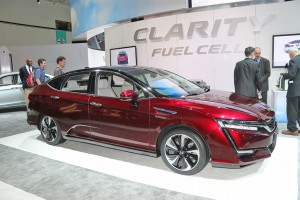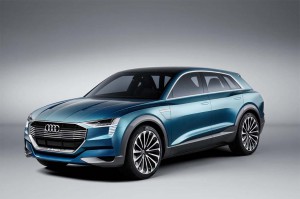
The L.A. Auto Show carved out a niche on the circuit as the showcase event for green technologies. However, that's changing to all auto technologies.
When it lifted the covers off its new Clarity Fuel-Cell Vehicle this week, Honda carried on a long-running L.A. Auto Show tradition of focusing on green automotive technology.
But where hybrids, plug-ins, battery-electric and hydrogen vehicles have dominated the annual Tinseltown event for much of the last two decades, environmentally friendly vehicles have had to share the stage this year. The 2015 show, in fact, opened with a day-long symposium on connected car technology, and much of the buzz during the media preview surrounded autonomous vehicles.
The L.A. Auto Show “has evolved from a single technology – environmental technology – to a broader range of technologies,” said American Honda Executive Vice President John Mendel.
Perhaps that’s no surprise, added Michael Sprague, chief operating officer of Kia Motors of America. “If you think about it, all the advanced green technologies, they’re all on the road now.”
Indeed, Kia’s sibling brand Hyundai was the first to bring a hydrogen car to the U.S. retail market in 2014 and when the Honda Clarity goes on sale next year there will be three fuel-cell vehicles. The Chevrolet Volt plug-in, first seen in L.A. at the beginning of the decade, is now in its second generation and Toyota is showing off the fourth new version of the world’s best-selling conventional hybrid, the Prius.

While the theme of this year's L.A. Auto Show may have shifted some, there was still plenty of green, like Audi's e-tron Quattro concept.
That’s not to say green technology is old hat. Audi came to Los Angeles with the e-tron Quattro Concept, a prototype of the 300-mile battery-electric SUV it plans to launch in 2015. That’s about triple what most current electric vehicles can deliver – with the exception of the Tesla Model S and new Model X lines – and longer range is the next big breakthrough, contends Audi’s U.S. planning chief Filip Brabec.
It’s what’s needed, he said, “to move electric vehicles into a mainstream proposition.”
The L.A. Auto Show is likely to see a lot more long-range battery-electric vehicles over the next few years. Chevrolet plans to launch the 200-mile Volt in late 2016. And there’ll be lots more plug-in hybrids. Mercedes-Benz alone is looking to introduce 10 of them by 2018.
But the novelty factor is certainly shifting to connected and autonomous vehicles. While Tesla has just launched its AutoPilot system, allowing motorists to drive hands-free on well-marked, limited-access highways, it’s likely to take until at least the end of the decade before the first fully autonomous vehicles are ready for the real world. Nissan promises to have one into production sometime in 2020.
And that’s a story worthy of L.A.’s other big industry. Until now, the idea of self-driving cars seemed little more than science fiction, whether in comedies like Woody Allen’s “Sleeper,” or thrillers like “Bladerunner.”
What the technology will mean to automakers and auto buyers alike is far from certain.
(Honda provides Clarity on fuel-cell leadership with new model. For more, Click Here.)
“Connectivity means different things to different people,” which may explain its broad appeal, suggested Roger Lanctot, associate director of the consulting firm, Strategy Analytics.
For some, it means having a broader link to the outside world with WiFi, Bluetooth, Apple CarPlay and smartphone apps. For others, it’s a way to significantly reduce roadway crashes. Mark Rosekind, the head of the National Highway Traffic Safety Administration, recently said we could be heading for an era where there are virtually no deaths on American roads.
For still others, connected car tech is about not just safe driving, but the ability to turn a car on autopilot and not stress out during the morning commute.
In an unusual move, Volvo’s L.A. Auto Show news conference focused on an interior buck, a model of a futuristic vehicle interior dubbed Concept26. Beyond allowing a driver to simply take their hands off the wheel, it would allow them to unfold a coffee tray, peck away at a built-in tablet computer, watch video on a 24-inch screen that pops out of the instrument panel, or simply lay back, relax, even catch a few more minutes of sleep before the workday begins.
(Click Here for details about how autonomous vehicles may improve fuel efficiency.)
“Volvo Concept 26 addresses the notion that driving can still be fun and liberating on the right day and on the right road,” says Anders Tylman-Mikiewicz, the general manager of Volvo’s Concept Center, where the prototype was developed.
One of the underlying questions of the 2015 L.A. Auto Show is how all this technology will impact not only what vehicles people buy in the future but how many vehicles they purchase.
At a Connected Car Expo session on carsharing, that was a central topic. Eric Spiegelman, the president of the Los Angeles Taxi Commission, noted that fully driverless vehicles – something the Uber service wants to develop – could be so cheap and available it makes little sense for many people to still own a car.
Joanna McFarland, founder of Hop, Skip Drive, a ride-sharing service for children, said that companies like hers could effectively replace the family minivan or SUV. “Does it make sense,” she asked, to have two or more vehicles in a household when ride-sharing services can take a youngster to soccer practice, or a parent to the bus station for the morning commute?
(To see more about Volvo’s autonomous Concept 26, Click Here.)
The technology trends highlighted by the 2015 L.A. Auto Show suggest that the cars that will be on display a decade from now will be radically cleaner and safer. But the industry may be selling far fewer of them. Auto sales are expected to hit an all-time record this year, and could nudge even higher in 2016. But the upward trend may not last for long.
